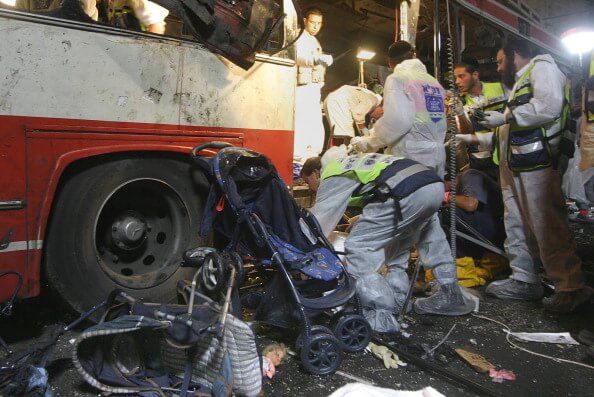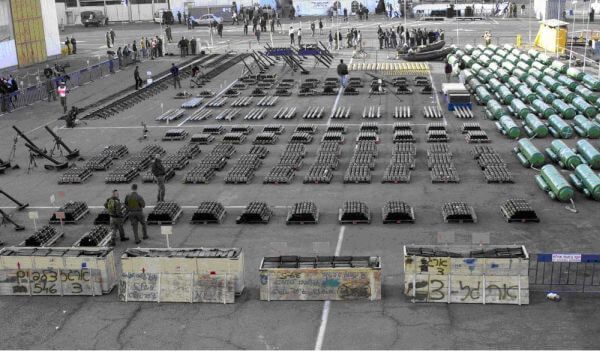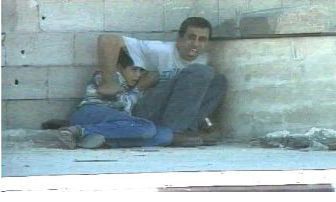“What do you call a society that has to just live every day with the idea that the pizza place you are eating in can just blow up without any warning?”
This question was asked by a teenager visiting the White House in NBC’s hit television show The West Wing, in a conversation about terrorism between high school students and White House staff.
Sam Seaborn, the fictional deputy communications director, played by Rob Lowe, answered her with one word:
“Israel.”
This show aired on October 3, 2001 and the writers nailed their description of life in Israel at that time, during the second Palestinian uprising, known as “the Second Intifada.”
Second Intifada Timeline
Just to list a few examples to give a sense for what was happening in Israel at the time:
- On March 26, 2001, a Palestinian sniper in Hebron aimed his gun at ten-month-old baby Shalhevet Pass who was sitting in her stroller near a public playground and pulled the trigger. He shot her in the head and she was killed instantly.
- On May 8, 2001, Israeli teenagers Koby Mandell and Yosef Ishran were hiking near their village when Palestinian terrorists killed them. According to USA Today, the boys were “bound, stabbed, and beaten to death with rocks…The walls of the cave in the Judean Desert were covered with the boys’ blood, reportedly smeared there by the killers.”
- On May 18, 2001, a Palestinian terrorist approached the Hasharon Mall in Netanya. His long coat aroused the suspicion of the security guard who stopped him from entering the mall. The terrorist detonated explosives attached to his body, killing six others and seriously injuring more than 50 people.
- On June 1, 2001, a Palestinian terrorist entered the Dolphinarium night club in Tel Aviv when it was filled with high school students. He detonated explosives that were attached to his body, killing 21 Israeli civilians and injuring 132.
- On August 9, 2001, a Palestinian terrorist entered the packed Sbarro pizza restaurant in downtown Jerusalem and detonated explosives, killing 15 civilians including two parents with their three children, a pregnant woman, and eight victims 18 years-old-and under. The attack injured 130 civilians. To give a sense for what “injured” means, a young mother named Chana Nachenberg remains in a permanent vegetative state and 15-year-old Miriam Shoshan had 60 nails lodged in her body, a hole in her right thigh, a ruptured spleen and third degree burns over 40 percent of her body.
- On December 1, 2001, at 11:30 pm on a Saturday night, two Palestinian terrorists detonated themselves in the crowded Ben Yehuda pedestrian mall in Jerusalem, killing 11 people, all between the ages of 14 and 21, and injuring 188.
- The very next day, on December 2, 2001, a Palestinian terrorist paid the bus fare for the No. 16 bus in Haifa, calmly boarded the bus, and then detonated an explosive device which was hidden under his clothing. He killed 15 people and injured 40 more, 17 of them critically.
These attacks continued way beyond 2001, peaking in March 2002 when Palestinian terrorists carried out 15 suicide missions to kill and maim Israeli civilians. And they continued for another three years.
Join the fight for Israel’s fair coverage in the news
Operation Defensive Shield
Of course, Israel had no choice but to retaliate and try to eliminate as many terrorists and their leaders as possible before they struck again.
Following a Palestinian suicide bombing on March 27, 2002 during the festive Passover holiday “Seder” meal which killed 30 people, Israel launched Operation Defensive Shield in the Palestinian areas of the West Bank. The Israel Defense Forces went deep into Palestinian cities and even besieged Palestinian leader Yasser Arafat in his Ramallah compound. Israeli security forces killed hundreds of Palestinian terrorists and arrested over 4,000. Thirty IDF soldiers were killed during the operation and 127 were wounded. Israel retook control over Palestinian areas to try to prevent further terror attacks emanating from those cities and villages.
When Palestinian terrorists fled into the Church of Nativity in Bethlehem for refuge from Israeli security forces, Israel had no choice but to surround the church. During the standoff, which lasted from April 2, 2002 to May 10, Israeli snipers killed 8 terrorists. The siege ended when 13 terrorists agreed to be deported to Europe.
The Palestinian terrorist groups Fatah, Hamas, and Islamic Jihad all agreed to a unilateral three-month ceasefire on June 29, 2003 but the terror attacks continued. When a Palestinian terrorist blew himself up on a crowded Jerusalem bus on August 19 killing 23 Israeli civilians, including seven children, Israel decided to go after Hamas leaders who were behind this and other attacks.

As the Palestinian terror attacks against Israelis continued, the Israeli Air Force killed Hamas leader Sheikh Ahmed Yassin on March 22, 2004. The attacks continued so on April 17, the IAF killed Yassin’s successor, Abdel Aziz al-Rantissi.
On May 2, 2004, Palestinian terrorists killed a pregnant woman and her four daughters and on May 11 and 12 they killed 13 IDF soldiers and mutilated their bodies. In order to retrieve the bodies and eliminate these terrorists, IDF forces raided Gaza neighborhoods killing close to 40 terrorists and causing great damage to the Zaitoun neighborhood, as the terrorists hid in civilian areas.
As IDF forces gained control over the suicide bombings with the intensive military operations in Palestinian areas and the beginning of the construction of a security barrier, Palestinian terrorists began turning to rockets from Gaza as a means of continuing the attacks against Israeli civilians.
On May 18, 2004, the IDF launched Operation Rainbow, striking the terrorist infrastructure of Rafah in Gaza, destroying smuggling tunnels, and stopping shipments of missiles and anti-tank rockets. The IDF killed 41 terrorists and destroyed approximately 50 Palestinian structures during the operation. Between September 2000 and May 2004, Israel found and destroyed 90 tunnels between Egypt and the Gaza Strip, many starting from civilian homes which had to be destroyed to eliminate the tunnel threat.
On September 29, 2004, after a Qassam rocket was fired from the Gaza Strip into the Israeli city of Sderot, killing two Israeli children, Israel launched Operation Days of Penitence to remove the rocket threat from Sderot and to kill the Hamas terrorists who were launching them. This meant entering Palestinian neighborhoods and camps where terrorists hid behind human shields, leading to serious damage to Palestinian refugee camps. During the two-week operation the IDF killed 100 Palestinians and prevented the firing of at least twelve Qassam rockets.
On October 21, 2004 the Israeli Air Force killed Adnan al-Ghoul, a senior Hamas bomb maker responsible for inventing the Qassam rocket.
Weapons smuggling
During the Second Intifada, which the Arab League pledged its support for, the IDF also caught numerous attempts to smuggle weapons into the Palestinian areas to arm the terrorists and fuel this uprising including:
- May 7, 2001 – the capture of the “Santorini,” which was sailing to Gaza from Lebanon with 40 tons of weapons worth $10 million, including Strela anti-aircraft missiles, mortars, rifles, grenades. mines, and artillery rockets.
- January 3, 2002 – the capture of the “Karine A,” a ship which sailed from Iran that was filled with 50 tons of weapons including short range Katyusha rockets, anti-tank missiles, and high explosives, and was heading to Palestinian terrorists.

- May 20, 2003 – the capture of the “Abu Hassan” fishing boat sailing from Lebanon to Egypt, filled with 25 Katyusha rocket detonators, rocket fuses, CDs explaining how to carry out suicide bombings, and a radio-activation system to donate bombs remotely. The small crew included a senior member of Hezbollah.
The end of the Second Intifada
While terror attacks never fully stopped, the Second Intifada came to an official end on February 8, 2005 when Palestinian President Mahmoud Abbas and Israel Prime Minister Ariel Sharon met in Sharm el-Sheikh and came to an agreement: All Palestinian factions agreed to stop all acts of violence against Israelis and Israel would cease its military activity against Palestinians. They reaffirmed their commitment to the peace process, and Israel agreed to release 900 of the 7,500 Palestinian prisoners being held in Israeli jails. Israel also agreed to withdraw its forces from the Palestinian towns it took control over in order to crack down on the terrorists and their leaders during the uprising.
In all, between 2001 and 2005 during their uprising, Palestinian terrorists killed over 1,000 Israelis and injured over 8,000. This was the most deadly of Israel’s wars with the exception of the War of Independence and the Yom Kippur War. 2,124 Palestinians were killed during the uprising including 466 members of Hamas, 408 from Fatah’s Tanzim and Al-Aqsa Martyrs’ Brigades, 205 from Islamic Jihad, and 334 from the Palestinian Authority security forces.
Aside from the loss of life, the Second Intifada caused Israel to lose tens of billions of dollars due to a decrease in tourism, caused billions of dollars of damage to Palestinian infrastructure, and scarred an entire generation.
Related Reading: Scarred by the Second Intifada, Peace is Hard for Israelis To Believe In
What was the cause of the Second Intifada?
What was the cause of the Second Intifada that led to so much bloodshed and loss, and a situation in which Israelis had to fear bombings when they boarded a bus or went out to eat?
The Arab world pointed to a visit by Israeli opposition leader Ariel Sharon to the Temple Mount in September 2000 as the cause. Palestinians did begin rioting soon after Sharon’s visit and there were calls on the loudspeakers on the Temple Mount calling for Palestinians to defend Al-Aqsa, which led to stone throwing at Jewish worshipers at the Western Wall. That led to a strong Israeli response and an escalation in violence that continued for weeks. In just one month, Palestinians killed 12 Israelis and wounded 65. The strong Israeli response led to the deaths of 141 Palestinians and thousands injured.

But the claim that the Second Intifada, an organized and well-armed uprising which included terrorists blowing up buses and eateries, killing over 1,000 people over the course of four years, because an Israeli leader visited the Temple Mount is absurd.
Related reading: Did Ariel Sharon Start the Second Intifada?
First of all, Sharon only visited there after the Israeli Interior Minister received an assurance from the security chief of the Palestinian Authority that no uproar would arise as a result of the visit. Jibril Rajoub, head of Preventive Security on the West Bank confirmed that Sharon could visit the sensitive area as long as he did not enter a mosque or pray publicly, rules which Sharon adhered to.
Second, the Temple Mount is the holiest site in the world to the Jewish faith. And while the Jordanian Waqf has official control over the site, Israel is in charge of its security and Jews visit there regularly. There would be no reason for Sharon’s visit to be the catalyst for such vicious assaults on Israeli civilians. As Sharon, himself, told reporters after his visit, “I came here as one who believes in coexistence between Jews and Arabs. I believe that we can build and develop together. This was a peaceful visit. Is it an instigation for Israeli Jews to come to the Jewish people’s holiest site?”
Related reading: Jewish Ties to the Temple Mount – What’s the Story?
Third, and most significantly, the Palestinians themselves say that Yasser Arafat planned the uprising as soon as the Camp David Summit in the summer of 2000 failed. Imad Falouji, the Palestinian Authority Communications Director, gave a speech in December 2000 in which he said that the Intifada “was carefully planned since the return of Yasser Arafat from the Camp David negotiations, rejecting the US conditions.”
Mamduh Nofal, former military commander of the Democratic Front for the Liberation of Palestine revealed that following Camp David, “Arafat told us, ‘Now we are going to fight so we must be ready.’”
Hamas leader Mahmoud al-Zahar revealed in September 2010 that in the summer of 2000 as soon as Arafat understood that ALL of his demands would not be met, he instructed Hamas, Fatah, and the Al-Aqsa Martyrs Brigades to begin attacking Israel. Mosab Hassan Yousef, son of Hamas founder Sheikh Hassan Yousef, has verified that the Second Intifada was pre-planned by Arafat.
One last proof comes from Arafat’s widow Suha who said the following in a television interview in Dubai in December 2012: “Immediately after the failure of Camp David, I met him in Paris upon his return…. Camp David had failed, and he said to me, ‘You should remain in Paris.’ I asked him why, and he said, ‘Because I am going to start an intifada.’”
Marwan Barghouti, leader of the Fatah Tanzim, who is now serving multiple life sentences for his role in coordinating fatal terror attacks during the Second Intifada, said that he and others used Sharon’s visit as a rallying cry, calling Palestinians in all cities to raise arms against Israel to protect the Palestinian holy site. But that it was planned well in advance of Sharon’s visit.
There was one other event which the Palestinian leadership used to incite the Palestinian street to join the uprising which Arafat had planned for a few months. On September 30, 2000, a video surfaced showing a Palestinian boy named Muhammad al-Durrah supposedly shot dead by IDF troops while being sheltered by his father in a Gaza Strip alley. The footage spread like wildfire, especially throughout the Arab world, and enraged Palestinians were inspired to attack Israelis to avenge Muhammad’s alleged murder. Years of investigations by various sources have indicated that not only was Muhammad not killed by IDF soldiers, but he may have not been killed at all and the entire episode was staged and faked.

During the Camp David Summit in the summer of 2000, Israel offered the Palestinians over 90% of what they wanted. Israel could not go further than that because those last concessions would have put Israel in grave danger. Yasser Arafat’s response to not getting everything that he asked for was to incite the Palestinians and their terror organizations to murder over 1,000 innocent Israelis and to create a situation in which Israelis had to fear for their lives as they went about their regular life activities.
Arafat died at the age of 75 on November 11, 2004. His last act as leader of the Palestinian people was planning and leading the Second Intifada, which led to no changes for his people and caused death and destruction for thousands of Israelis and Palestinians.
Liked this article? Follow HonestReporting on Twitter, Facebook, Instagram and TikTok to see even more posts and videos debunking news bias and smears, as well as other content explaining what’s really going on in Israel and the region.


